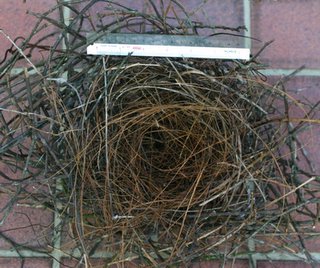House Crows’ nests

 There have been a number of postings on nesting crows recently - by Angie, Tang and Eu Heng. And we have published images of their large nests. Below is a detailed account of the nests and readers can always give feedback of other nesting materials.
There have been a number of postings on nesting crows recently - by Angie, Tang and Eu Heng. And we have published images of their large nests. Below is a detailed account of the nests and readers can always give feedback of other nesting materials.House Crows (Corvus splendens) build their nests firmly lodged between the branching forks of tall trees and the frond bases of tall palms. The description of a nest I am giving comes from one dislodged from a ceram palm (Rhopaloblaste ceramica) in my garden. Normally the crows recycle the materials from the old nest to construct a new one. And unless someone climbs up the tree or palm and remove a disused nest, there would be no opportunity to examine one closely.
The large, crude nest is composed of interlocking twigs, in this case coming mainly from the many mempat trees (Cratoxylum formosum) lining the road fronting my house. Together with these twigs are pieces of wires of various lengths and thickness picked up from my garden, no doubt to strengthen the nest structure.
The nest measures 40 cm x 40 cm and 30 cm deep. Sitting in the centre of this massive structure is a neat shallow cup lined with light brown plant fibres, probably palm fibres.
In the nest observed by Hung Bun Tang there were knotted lengths of thick plastic. These are the pieces attached to the infernal smoky petrol-driven machines of our wayside grass cutters, as KF Yap so aptly put it. The sweeping, circular motion of the pieces cuts off the grass blades. These plastic pieces often get detached, sometimes hitting passersby. The crows have obviously found a new use for these discarded plastic pieces.
Straycat in his blog recounts the time when clothes hangers disappeared from his backyard. The mystery was solved when a nearby House Crows’ nest was seen with hangers jutting out from the side.
House Crows do not normally reuse the old nest after one breeding session. But they reuse the nesting materials. In my two palms they would collect the materials from the old nest in one palm to build a new nest in nearby palm. This went on every three months for more than two years before they decided to move on to another area to breed.
Both parent crows help to construct the nest. Sometimes they are assisted by other crows. The breeding female usually takes care of the lining of the nest towards the end of the building session. In this respect they behave just like the American Crow (Corvus brachyrhynchos).
Labels: Nesting



0 Comments:
Post a Comment
<< Home